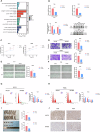TNC upregulation promotes glioma tumourigenesis through TDG-mediated active DNA demethylation
- PMID: 39090080
- PMCID: PMC11294444
- DOI: 10.1038/s41420-024-02098-w
TNC upregulation promotes glioma tumourigenesis through TDG-mediated active DNA demethylation
Abstract
Gliomas represent the most predominant primary malignant tumor in central nervous system. Thymine DNA glycosylase (TDG) is a central component in active DNA demethylation. However, the specific mechanisms of TDG-mediated active DNA demethylation in gliomas remain unclear. This research indicates TDG expression is overexpressed in gliomas and correlated with poor prognosis. TDG knockdown suppressed the malignant phenotype of gliomas both in vitro and vivo. Notably, RNA-seq analysis revealed a strong association between TDG and tenascin-C (TNC). ChIP-qPCR and MeDIP-qPCR assays were undertaken to confirm that TDG participates in TNC active DNA demethylation process, revealing decreased DNA methylation levels and elevated TNC expression as a result. Silencing TNC expression also suppressed the tumor malignant phenotype in both in vitro and in vivo experiments. Additionally, simultaneous silencing of TNC reduced or even reversed the glioma promotion caused by TDG overexpression. Based on our findings, we conclude that TDG exerts an indispensable role in TNC active DNA demethylation in gliomas. The DNA demethylation process leads to alternations in TNC methylation levels and promotes its expression, thereby contributing to the development of gliomas. These results suggest a novel epigenetic therapeutic strategy targeting active DNA demethylation in gliomas.
© 2024. The Author(s).
Conflict of interest statement
The authors declare no competing interests.
Figures







Similar articles
-
Thymine DNA glycosylase can rapidly excise 5-formylcytosine and 5-carboxylcytosine: potential implications for active demethylation of CpG sites.J Biol Chem. 2011 Oct 14;286(41):35334-35338. doi: 10.1074/jbc.C111.284620. Epub 2011 Aug 23. J Biol Chem. 2011. PMID: 21862836 Free PMC article.
-
Gadd45a promotes DNA demethylation through TDG.Nucleic Acids Res. 2015 Apr 30;43(8):3986-97. doi: 10.1093/nar/gkv283. Epub 2015 Apr 6. Nucleic Acids Res. 2015. PMID: 25845601 Free PMC article.
-
Roles of TET and TDG in DNA demethylation in proliferating and non-proliferating immune cells.Genome Biol. 2021 Jun 22;22(1):186. doi: 10.1186/s13059-021-02384-1. Genome Biol. 2021. PMID: 34158086 Free PMC article.
-
The Role of Thymine DNA Glycosylase in Transcription, Active DNA Demethylation, and Cancer.Cancers (Basel). 2022 Feb 1;14(3):765. doi: 10.3390/cancers14030765. Cancers (Basel). 2022. PMID: 35159032 Free PMC article. Review.
-
Structural and mutation studies of two DNA demethylation related glycosylases: MBD4 and TDG.Biophysics (Nagoya-shi). 2014 Oct 18;10:63-8. doi: 10.2142/biophysics.10.63. eCollection 2014. Biophysics (Nagoya-shi). 2014. PMID: 27493500 Free PMC article. Review.
Cited by
-
Inhibitor of Growth Proteins: Epigenetic Regulators Shaping Neurobiology.Biomolecules. 2025 Feb 14;15(2):281. doi: 10.3390/biom15020281. Biomolecules. 2025. PMID: 40001584 Free PMC article. Review.
-
Functional germline variants in DNA damage repair pathways are associated with altered survival in adults with glioma treated with temozolomide.medRxiv [Preprint]. 2024 Oct 10:2023.10.13.23296963. doi: 10.1101/2023.10.13.23296963. medRxiv. 2024. Update in: Neuro Oncol. 2025 Jun 21;27(5):1385-1398. doi: 10.1093/neuonc/noae275. PMID: 39417102 Free PMC article. Updated. Preprint.
-
Functional germline variants in DNA damage repair pathways are associated with altered survival in adults with glioma treated with temozolomide.Neuro Oncol. 2025 Jun 21;27(5):1385-1398. doi: 10.1093/neuonc/noae275. Neuro Oncol. 2025. PMID: 39745907
-
Predicting podoplanin expression and prognostic significance in high-grade glioma based on TCGA TCIA radiomics.PLoS One. 2025 Jun 24;20(6):e0325964. doi: 10.1371/journal.pone.0325964. eCollection 2025. PLoS One. 2025. PMID: 40554484 Free PMC article.
References
Grants and funding
LinkOut - more resources
Full Text Sources
Miscellaneous

